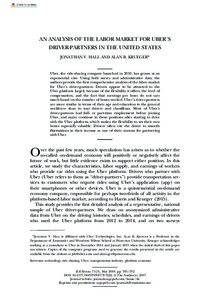An analysis of the labor market for Uber's driver-partners in the United States

Hall, Jonathan V. ; Krueger, Alan B.
2018
71
3
May
705-732
sharing economy ; transport worker ; digitalisation ; labour supply ; wages
Economics
https://doi.org/10.1177%2F0019793917717222
English
Bibliogr.
" Uber, the ride-sharing company launched in 2010, has grown at an exponential rate. Using both survey and administrative data, the authors provide the first comprehensive analysis of the labor market for Uber's driver-partners. Drivers appear to be attracted to the Uber platform largely because of the flexibility it offers, the level of compensation, and the fact that earnings per hour do not vary much based on the number of hours worked. Uber's driver-partners are more similar in terms of their age and education to the general workforce than to taxi drivers and chauffeurs. Most of Uber's driver-partners had full- or part-time employment before joining Uber, and many continue in those positions after starting to drive with the Uber platform, which makes the flexibility to set their own hours especially valuable. Drivers often cite the desire to smooth fluctuations in their income as one of their reasons for partnering with Uber."
Digital;Paper
The ETUI is co-funded by the European Union. Views and opinions expressed are however those of the author(s) only and do not necessarily reflect those of the European Union or the ETUI.